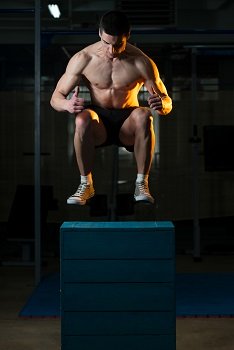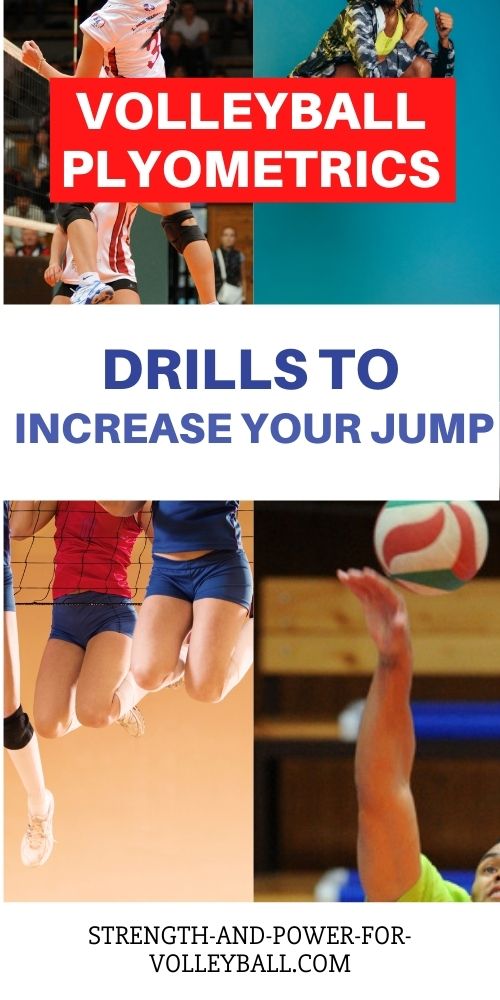Jump Training Tips
Plyometric Volleyball Exercises
Plyometric volleyball exercises or jump training should be done quickly with the purpose of training muscles to be more powerful. The purpose of volleyball training by jumping is to train the muscles to pre-stretch before jumping. During this pre-stretch, energy is stored in the muscle which can be used to jump higher.
For example, when performing a counter movement prior to jumping, elastic energy is stored in the muscles of the legs. If the counter movement is performed quickly, the energy that's stored can be used to aid in jumping higher. If the counter movement is performed too slowly, the energy will be lost.
The intensity of plyometric volleyball exercises or jumping drills refers to how much stress is placed on muscles, connective tissues, and joints.
Are you Ready for 40 Inch Box Jumps?
Low Intensity Plyometric Volleyball Exercises
Two Foot Ankle Hops
Direction of Jump:
Vertical.
Starting Position:
Stand with a comfortable stance with feet shoulder width apart.
Beginning Movement:
Begin the jump with a slight counter movement.
Upward Movement:
Hop up moving primarily at the ankle joint.
Downward Movement:
Land in the starting position and immediately hop back up.
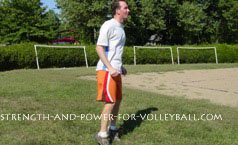
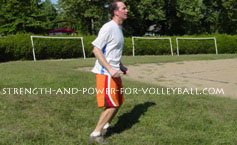
Forward Skip
Direction of Jump:
Horizontal and Vertical
Starting Position:
Start with one leg raised up to 90 degree hip and knee flexion.
Arm Action:
Reciprocal arm action. As one leg is lifted, raise the opposite arm.
Beginning Movement:
Start with a countermovement on one leg.
Upward Movement:
Jump up and forward off of one leg. The opposite leg should remain in a flexed position until landing.
Downward Movement:
Land and repeat the skip with the opposite leg.
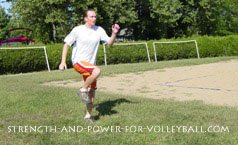
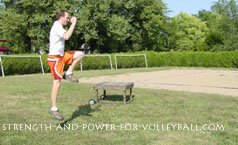
Skip with Kickback
Direction of Jump:
Vertical and Horizontal
Starting Position:
Start with one leg raised up to 90 degree hip and knee flexion.
Arm Action:
Reciprocal arm action. As one leg is lifted, raise the opposite arm.
Beginning Movement:
Start with a countermovement on one leg.
Upward Movement:
Jump up and forward on one leg. This just like a regular skip except this time kick your top leg back.
Downward Movement:
Land and repeat the skip with the opposite leg.
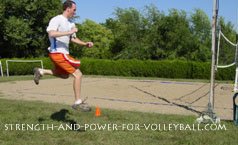
Double Leg Vertical Jump
Direction of Jump:
Vertical
Arm Action:
Double arm action.
Starting Position:
Stand with a comfortable stance with feet shoulder width apart.
Beginning Movement:
Start by swinging your arms back and perform a countermovement.
Upward Movement:
Explosively jump up, using both arms to reach up high.
Downward Movement:
Landing in the starting position.
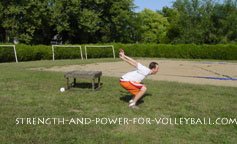
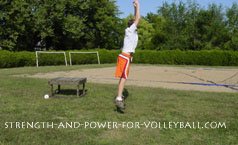
Medium Intensity Plyometric Volleyball Exercises
Lateral Cone Hops
Direction of Jump:
Vertical and lateral.
Starting Position:
Stand with a comfortable stance, feet shoulder width apart next to a cone.
Beginning Movement:
Perform a countermovement hopping sideways over the cone.
Upward Movement:
Hop explosively up and over the cone.
Downward Movement:
Land on the other side and the cone and quickly hop back over the cone.
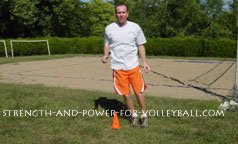
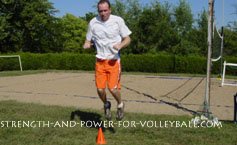
Split Squat Jump
Direction of Jump:
Vertical
Arm Action:
Double arm action.
Starting Position:
Stand in a lunge position with one leg forward (hip and knee joints at 90 degrees) and the back leg behind the midline of the body.
Beginning Movement:
Start with a countermovement.
Upward Movement:
Explosively jump up emphasizing maximum height.
Downward Movement:
When landing, maintain the lunge position. Immediately repeat the jump.
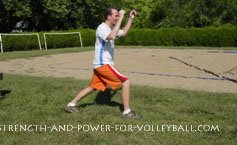
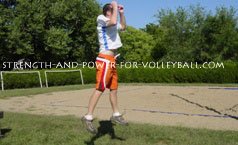
Double Leg Tuck Jump
Direction of Jump:
Vertical
Starting Position:
Stand with a comfortable stance with feet shoulder width apart.
Beginning Movement:
Start with a countermovement.
Upward Movement:
Explosively jump up, bringing your knees to your chest.
Downward Movement:
Land in the starting position and immediately jump back up.
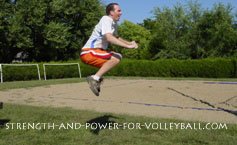
Double Leg Butt Kick
Direction of Jump:
Vertical
Starting Position:
Stand on the ground in a comfortable stance with feet shoulder width apart.
Beginning Movement:
Start with a countermovement.
Upward Movement:
Explosively jump up, bringing your feet to your butt.
Downward Movement:
Land in the starting position and immediately jump back up.
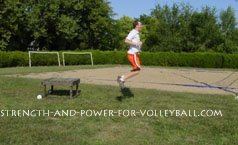
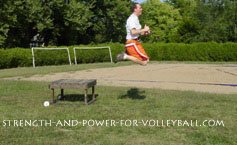
High Intensity Plyometric Volleyball Exercises
Single Leg Vertical Jump
Direction of Jump:
vertical
Arm Action:
Double arm action.
Starting Position:
Stand on the ground in a comfortable upright stance.
Beginning Movement:
Start by swinging your arms back and performing a countermovement.
Upward Movement:
Explosively jump up using your arms to assist. Emphasizing maximum height and reach high.
Downward Movement:
Land in the starting position and repeat the jump using the same leg. Allow recovery between jumps. After a rest, repeat jumps with the opposite leg.
When performing depth jumps, time spent on the ground should be kept at a minimum. Intensity may be increased by increasing the height of the box.
First, start with a box 12 inches high. When you can depth jump up to the same height as the box, you can increase box height.
Squat Depth Jumps and Depth Jumps are the most intense plyometric volleyball exercises and should only be attempted by advanced athletes.
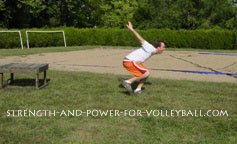
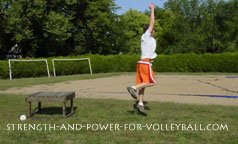
Squat Depth Jump
Direction of Jump:
Vertical
Starting Position:
Stand on the box near the edge in a comfortable upright stance.
Beginning Movement:
Step off the box.
Downward Movement:
Land on the floor in a squat position, 90 degrees hip and knee flexion.
Upward Movement:
After landing, jump up as high as possible then land in the same squat position.
When stepping from the box, dont step down or jump up off the box because this would change the height from which the exercise will be performed.
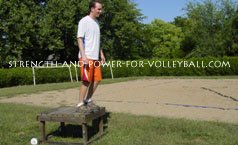
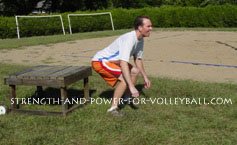
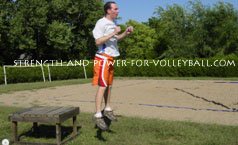
Depth Jump
Direction of Jump:
Vertical
Starting Position:
Stand on the box near the edge in a comfortable upright stance.
Beginning Movement:
Step off the box.
Downward Movement:
Land on the ground with both feet.
Upward Movement:
Upon touchdown, immediately jump up as high as possible.
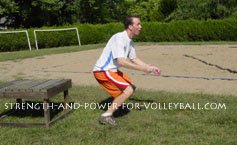

Note: All the plyometric volleyball exercises that involve using the arms to aid in jumping higher can also be done without using the double arm action.
Static Flexibility Training
Volleyball › Volleyball Conditioning › Plyometrics
